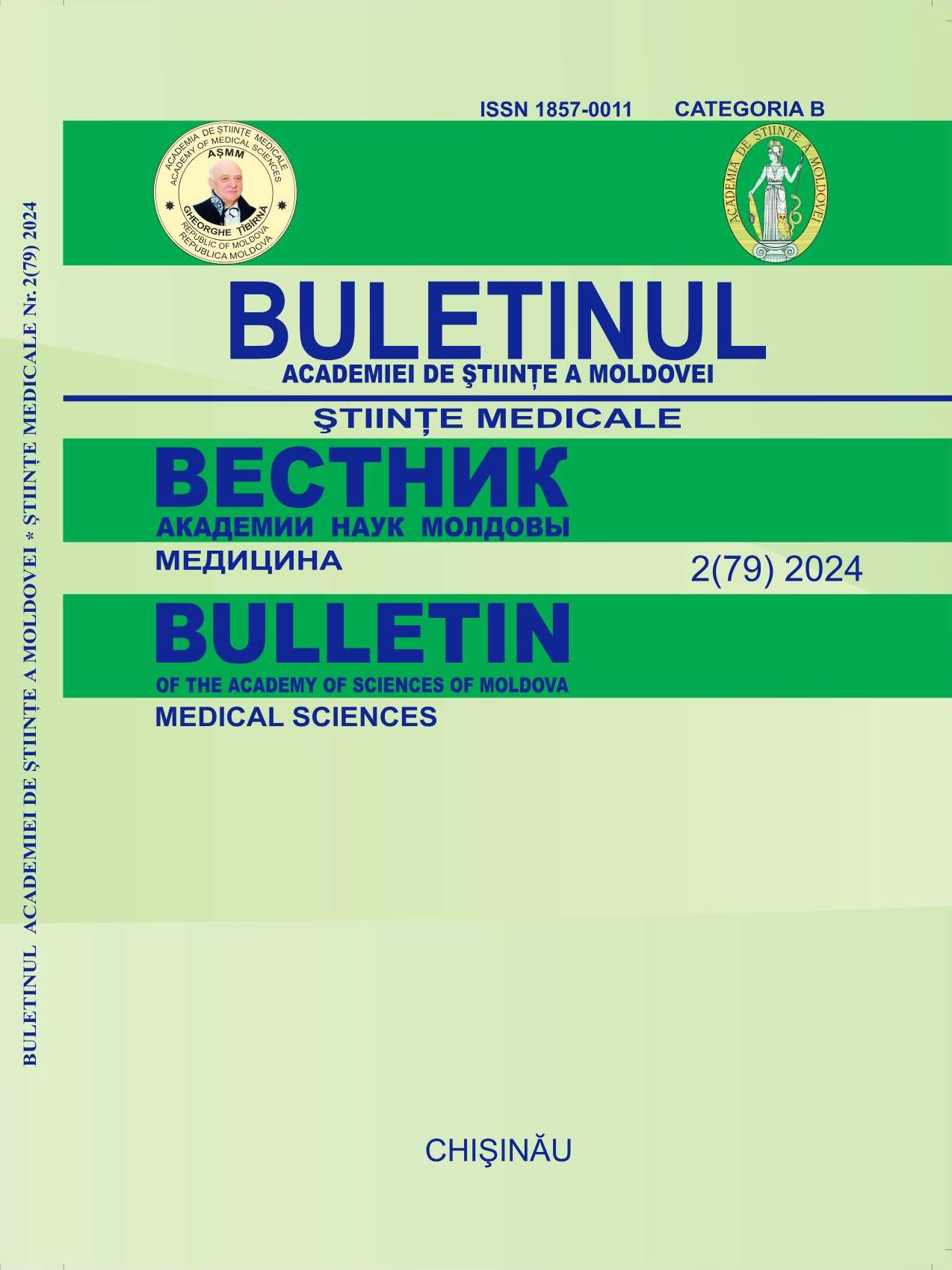Антибиотикотерапия у нейрохирургических пациентов как средство обхода гематоэнцефалического барьера - оправдано ли это?
DOI:
https://doi.org/10.52692/1857-0011.2024.2-79.44Ключевые слова:
антибиотерапия, инфекция, гематоэнцефалический барьер, нейрохирургияАннотация
Антибиотикотерапия у нейрохирургических пациентов как средство обхода гематоэнцефалического барьера - оправдано ли это?Гематоэнцефалический барьер (ГЭБ) является важным механизмом для сосудистой динамики центральной нервной системы (ЦНС). Он обладает множеством свойств, которые предотвращают дисбаланс гомеостаза. Проведен систематический обзор литературы, включавший 65 источников, основанных исключительно на исследованиях проведенных на людях. Были выявлены и описаны потенциальные пути введения препаратов а также препятствия для фармакотерапии. В заключение, антибиотикотерапия остается актуальной темой для обсуждения благодаря множеству различных и часто противоречивых фармакодинамических свойств, проявляемых антибиотиками в различных патологических состояниях.
Библиографические ссылки
Tan Q. et al. Getting drugs to the brain: advances and prospects of organic nanoparticle delivery systems for assisting drugs to cross the blood-brain barrier. Journal of Materials Chemistry B, 2022; 10(45):9314- 9333.
Banks W.A. Characteristics of compounds that cross the blood-brain barrier. BMC Neurology, 2009; 9(1):1-5.
Khawli L.A. et al. Drug delivery across the blood- brain barrier. Molecular Pharmaceutics, 2013; 10(5):1471-1472.
Viscusi E.R. et al. Blood-brain barrier: Mechanisms governing permeability and interaction with peripherally acting μ-opioid receptor antagonists. Regional Anesthesia and Pain Medicine, 2020; 45(9):688–695.
Tamai I. et al. Transporter-mediated permeation of drugs across the blood-brain barrier. Journal of Pharmaceutical Sciences, 2000; 89(11):1371–1388.
Liu L.H. Antibiotic delivery across the blood-brain barrier by nanoparticle system. 2008.
Nau R. et al. Penetration of drugs through the blood- cerebrospinal fluid/blood-brain barrier for treatment of central nervous system infections. Clinical Microbiology Reviews, 2010; 23(4):858-883.
Haddad N. et al. The Blood–Brain Barrier and Pharmacokinetic/Pharmacodynamic Optimization of Antibiotics for the Treatment of Central Nervous System Infections in Adults. Antibiotics, 2022; 11(12):1-37.
Yuan M. et al. Ceftazidime/avibactam combined with colistimethate sodium successfully cures carbapenem- resistant Pseudomonas aeruginosa-induced brain abscess in a child post-craniotomy: a case report. Frontiers in Oncology, 2024; 14(0):1-8.
Brockner O. et al. Intensive Care Medicine Cefotaxime in Treatment of Meningitis and Ventriculitis? Evaluation of Drug Concentrations in Human Cerebrospinal Fluid. Intensive Care Med, 1982; 8(1):33-38.
Hosmann A. et al. Linezolid brain penetration in neurointensive care patients. Journal of Antimicrobial Chemotherapy, 2024; 79(3):669–677.
Lallani S.B. et al. Use of an Intracranial Drain as a Conduit for Treatment of an Intracranial Streptococcus intermedius Abscess. Cureus, 2021; 13(4):1-6.
Schneider F. et al. Efficacy of Vancomycin and Meropenem in Central Nervous System Infections in Children and Adults: Current Update. Antibiotics, 2022; 11(2):1-22.
Mrowczynski O.D. et al. Intra-cerebrospinal fluid antibiotics to treat central nervous system infections: A review and update. Clinical Neurology and Neurosurgery, 2018; 170(0):140-158.
Chusri S. et al. Outcomes of adjunctive therapy with intrathecal or intraventricular administration of colistin for post-neurosurgical meningitis and ventriculitis due to carbapenem-resistant acinetobacter baumannii. International Journal of Antimicrobial Agents, 2018; 51(4):646–650.
Hu Y. et al. Intrathecal or intraventricular antimicrobial therapy for post-neurosurgical intracranial infection due to multidrug-resistant and extensively drug- resistant Gram-negative bacteria: A systematic review and meta-analysis. International Journal of Antimicrobial Agents, 2019; 54(5):556-561.
Li C. et al. Treatment of Ventriculitis and Meningitis After Neurosurgery Caused by Carbapenem-Resistant Enterobacteriaceae (CRE): A Challenging Topic. Infection and Drug Resistance, 2023; 16(0):3807-3818.
Knoop M. et al. Antibiotic prophylaxis in cerebrospinal fluid shunting: Reassessment of Cefotiam penetration into human CSF. Zentralblatt Fur Neurochirurgie, 2007; 68(1):14–18.
Wang J.F. et al. Blood-brain barrier penetration of cefepime after neurosurgery. Chin Med J (Engl), 2007; 120(13):1176-1178.
Abu Bakar A. et al. An Unusual Case of the Successful Treatment of Carbapenem-resistant Ventriculitis with Intravenous Colistin. Cureus, 2020; 12(2):1-5.
Fuhr U. et al. CSF Pharmacokinetics of Ceftazidime in Neurosurgical Patients with an External Ventriculostorny. Infection, 1989; 17(1):21–22.
McLaurin R.L. Treatment of infected ventricular shunts. Childs Brain, 1975; 1(5):306-310.
Cook A.M. et al. Linezolid for the treatment of a heteroresistant Staphylococcus aureus shunt infection. Pediatric Neurosurgery, 2005; 41(2):102–104.
Nau R. et al. New Antibiotics for the Treatment of Nosocomial Central Nervous System Infections. Antibiotics, 2024; 13(1):1-13.
Wang Q. et al. Postoperatively administered vancomycin reaches therapeutic concentration in the cerebral spinal fluid of neurosurgical patients. Surgical Neurology, 2008; 69(2):126–129.
Guo W. et al. Successful treatment of extensively drug-resistant Acinetobacter baumannii ventriculitis with polymyxin B and tigecycline- a case report. Antimicrobial Resistance and Infection Control, 2018; 7(1):1-4.
Wu P. et al. KHDRBS3 regulates the permeability of blood–tumor barrier via cDENND4C/miR-577 axis. Cell Death and Disease, 2019; 10(7):1-15.
Johanson C. et al. Merging Transport Data for Choroid Plexus with Blood-Brain Barrier to Model CNS Homeostasis and Disease More Effectively. CNS & Neurological Disorders - Drug Targets, 2016; 15(9):1151–1180.
Mounier R. et al. Is First-Line Vancomycin Still the Best Option to Treat Staphylococcus Health Care– Associated Meningitis? World Neurosurgery, 2017; 99(0):1-19.
Croitoru D. et al. Surgical site infections in open craniotomy – a narrative literature review. Sănătate Publică, Economie și Management în Medicină, 2024; 101(4):36-40.
Загрузки
Опубликован
Лицензия
Copyright (c) 2025 Вестник Академии Наук Молдовы. Медицина

Это произведение доступно по лицензии Creative Commons «Attribution» («Атрибуция») 4.0 Всемирная.



